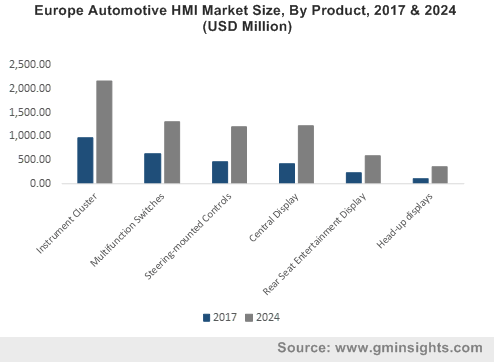Automotive Human Machine Interface (HMI) Market to be characterized by the launch of cutting-edge technologies, passenger vehicles segment to emerge as potential investment hub by 2024
Publisher : Fractovia | Published Date : 2018-10-31Request Sample
With the global automotive industry surfing along the wave of autonomous and self-driving cars, the commercialization potential of automotive HMI market has scaled several notches up over the past few decades. The global automotive HMI market valuation of over USD 11 billion in 2017 is a vivid data bearing testimony to the robust growth of this business sphere in the recent years. Reports claim that the rapid proliferation and integration of advanced technologies such as virtual reality (VR), Internet of Things, Cloud-based software, and Machine Learning with automotive hardware has lead the way to the deployment of massive automotive HMI, in turn enabling the smooth interaction between the driver and the vehicle.
Europe Automotive HMI Market Size, By Product, 2017 & 2024 (USD Million)

Identifying the exponentially increasing demand for potential human machine interface to meet the needs of the advanced automotive designs, several companies operating in this business sphere are going the whole hog to bring in product innovation, and expanding their production capabilities to meet the robust demand. Recently for instance, Altia made an announcement of its HMI code generation supports for the newly launched Renesas R-Car E3 system-on-chip (SoC). The integration of Altia’s code generation software and R-Car E3 SoC will be available for all the global automotive OEM production programs. If reports are to be believed, the combination of Altia and Renesas will offer the customers the opportunity to build the latest and desirable HMI innovations into advanced embedded displays tailored for latest Renesas hardware technology.
With such next-generation technologies, it comes as no surprise that the HMI platform in the automotive industry is gaining phenomenal traction as it is enabling vehicle-to-vehicle communication, while aiding the manufactures in providing wide array of services such as on-board media streaming, personal assistant, and predictive maintenance services. The global automotive HMI industry is further expected to garner hefty proceeds, given the increasing interest of automakers in integrating their models with safer, more attractive, and entertaining features. It has been witnessed that the core industry players are in fact gearing up their production capabilities as the demand for smart navigation, self-driving features, and telematics technologies are further taking the automotive production by storm.
Denso’s massive investment in elevating JOLED’s mass production of in-vehicle OLED displays – is an apt instance bearing substantiation to the aforesaid. The in-vehicle OLED displays, for the record are used for HMI in automobile cockpits to deliver important information to drive swiftly & accurately. Reports reveal that JOLED’s OLED displays offer HD images & more clear colors in comparison with the conventional HMIs that usually uses the thin-film transistor liquid crystal displays. The OLED displays are also designed to be thinner, bendable, and lighter in turn making them easy to install and capable to produce optimized light output for improved functionality. Industry experts claim that Denso’s investment of USD 270 million in JOLED will enable it to combine its HMI technology & expertise, thereby speeding the development & mass production of OLED displays for center-stack displays, instrument clusters and other devices, contributing to more attractive and convenient digital cockpits for streamlined interaction between human and machine.
Such product innovation and capacity expansion trends promise to be one of the most prominent drivers impelling the commercialization potential of global automotive HMI market. A report by Global Market Insights, Inc., further throws light on the growth graph of automotive human machine interface market and further forecasts the global valuation to surpass USD 27 billion by 2024, with an estimated CAGR of 12% over 2018-2024. The report also highlights that, in terms of vehicles, passenger vehicle segment will be the most lucrative investment ground as it is estimated to account for 80% of the global automotive HMI industry share by 2024.
The rapid demand for major luxury and passenger cars such as BMW, Audi, Volkswagen, and Porsche especially in North America, Asia Pacific, & Middle East regions, the business landscape of automotive HMI industry is sure to tread along a profitable roadmap in the ensuing years. Given that the expanse of this sphere spans numerous geographies & mammoth participations of industry players, the automotive human machine interface market will emerge as a lucrative business space for potential investors in the ensuing years.